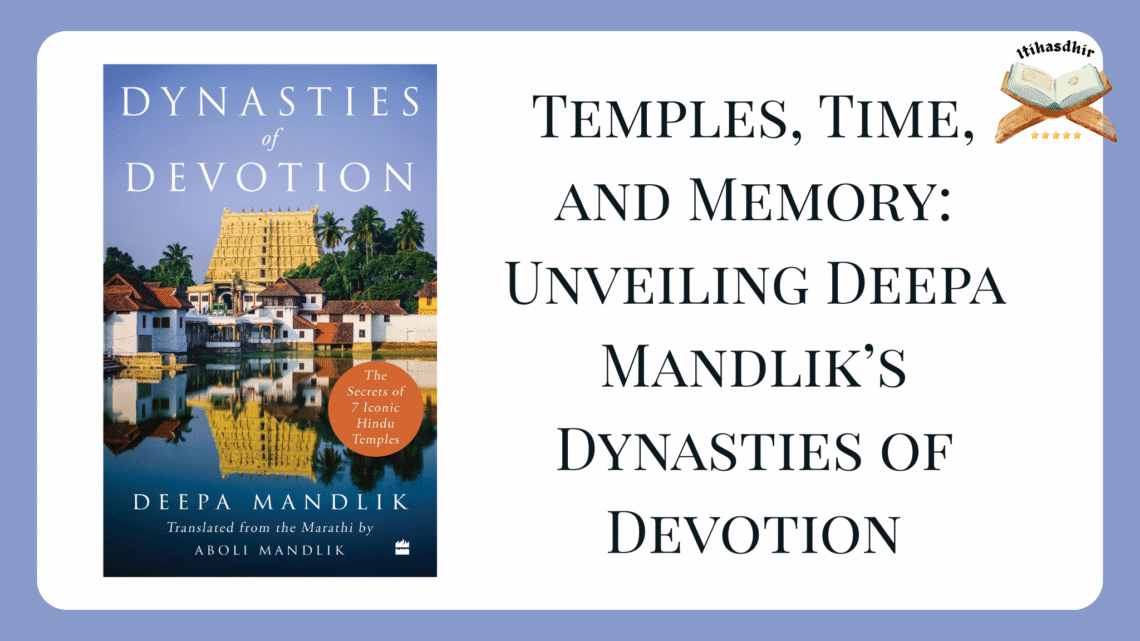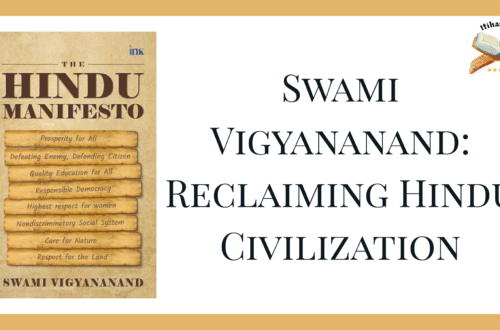
Where Temples Speak and Histories Whisper: A Journey with Deepa Mandlik
India’s temples have always been more than stone or ritual—they are vessels of heritage, culture, and unbroken faith. Deepa Mandlik’s Dynasties of Devotion is not just a book; it’s a journey that invites the reader to linger in the shadows of spires, decipher legends in sculpture, and experience the essence of Indian history through seven extraordinary temples stretching from Maharashtra and Tamil Nadu to the Khmer heartland of Cambodia. To a reader like me, who loves to travel and explore temples, with the recent example of the 8 Aṣtavināyaka Temples in Maharashtra, this book was like a pilgrimage in itself.
The Book’s Spirit: Weaving Story With Stone
Unlike most academic treatises, Mrs. Mandlik employs a first-person, travelogue style that balances meticulous research with the intimacy of lived experience. Each chapter is a time capsule, where empires, dynasties, and artisans meet. The narrative pulses with nostalgia and wonder—evoking not only the grandeur of temple architecture, but the daily life, dances, and even the marketplaces that once flourished around these sacred sites. The emotional axis of the book is its reverence—for creation, for continuity, for shared belief.
Temple Chronicles: Seven Worlds of Wonder
Kailāsa Temple, Ellora
Carved entirely from solid basalt rock in the 8th century CE by Rashtrakuta king Krishna I, the Kailāsa Temple is a monumental homage to Mount Kailash. Built top-down, its construction entailed removing over 200,000 tonnes of rock, resulting in a multi-tiered complex with elaborate carvings of Hindu mythology. The severed heads of the Saptamātṛkās remind visitors of its turbulent past, but the temple remains a marvel of monolithic architecture and artistic vision.
Bṛhadīšwara Temple, Thanjavur
Commissioned by Rajaraja Chola I in 1010 CE, this granite colossus was completed in just six years, its massive 216-foot vimana never tilting despite being built with over 130,000 tonnes of stone. The temple’s foundation is five feet deep, and its construction without mortar is a study in Chola engineering genius. The temple once housed hundreds of dancers and musicians, and its sculptural wealth and inscriptions provide a vivid picture of Chola society. Later, the Maratha gate was added, marking the region’s 150-year Maratha rule. This serves as a powerful distinction between the Hindu dynasties that sought to enrich such legacies and the later Islamic dynasties that sought to destroy them.
Airāvatešvara Temple, Darasuram
Built by Rajaraja Chola II in the mid-12th century, this temple is famed for its “musical steps”—seven stone stairs that produce musical notes when struck. Designed as a celestial chariot, the temple features intricate sculptures and a star-shaped sanctum. The destruction of its gopuras reflects the passage of time, but the surviving art and architecture stand as a testament to the Cholas’ blend of science and spirituality.
Bṛhadīšwara Temple, Gangaikondacholapuram
Constructed by Rajendra Chola I after his conquest of the Ganga region, this temple is the last vestige of a once-great imperial capital. Its elegant vimana and massive Shiva linga are architectural highlights, and the positioning of the Nandi statue to reflect sunlight into the sanctum shows sophisticated design. Sadly, the surrounding city was erased by history and the temple’s granite was plundered by the British for dam construction.
Chennakeśava Temple, Belur
Built by the Hoysala king Vishnuvardhana in 1117 CE, this temple took over a century to complete. Famous for its soapstone carvings and “gravity pillar” that levitates without a base, the temple’s star-shaped platform is adorned with delicate sculptures, including figures inspired by Queen Shantaladevi. The dual religious patronage (Queen remained Jain while the King converted to Vaishnavism) illustrates the temple’s embrace of religious pluralism and women’s autonomy.
Padmanābhaswāmy Temple, Thiruvananthapuram
Originating in the 8th century but extensively renovated in the 18th, this temple blends Dravidian and Kerala styles. Known for its towering gopuram, stone corridors, and the colossal reclining Vishnu idol, the temple is as much a spiritual center as a royal symbol. Its construction techniques—massive stone slabs raised without modern machinery—remain mysterious, and its legendary underground vaults reflect both its wealth and architectural ingenuity.
Angkor Wat & Angkor Thom, Cambodia
Angkor Wat (12th century, Suryavarman II) is the world’s largest religious monument, built as a Hindu temple dedicated to Vishnu and later converted to Buddhist use. Its design symbolizes the Hindu cosmos, with five towers representing Mount Meru. Constructed from millions of sandstone blocks, the temple features intricate bas-reliefs and precise celestial alignments. Angkor Thom, the nearby walled city, boasts the Bayon temple with its iconic face towers and murals depicting Khmer daily life, including prominent roles for women. Both sites exemplify the cultural exchange between India and Southeast Asia and remain enduring symbols of Khmer architectural brilliance.
Shadows of Destruction and Neglect: A Lament for Lost Temples
The journey across India’s sacred temples is also a chronicle of their vulnerability—first to the sword, then to indifference. Dynasties of Devotion does not shy away from highlighting how waves of Islamic invasions brought direct destruction to some of the subcontinent’s most magnificent shrines: gopuras toppled, idols desecrated, and treasures looted, acts often intended to erase the cultural and spiritual bedrock of dharma. Later, under British colonial rule, neglect and utilitarian disdain continued the damage—nowhere more poignantly illustrated than when British engineers dismantled portions of the Gangaikondacholapuram temple, repurposing centuries-old granite for dam construction. These episodes are tragic not only for the architectural marvels lost, but for the rupture they caused in the historical and religious continuity of a civilization, severing communities from living expressions of their faith and heritage. The result is an irreplaceable loss: of artistry, of sacred traditions, and of the vibrant dharmic ethos that once flourished, leaving behind silence where music and devotion once echoed.
Beyond Stone: Women, Power, and Social Life
Mrs. Mandlik’s exploration is deeply attentive to the agency and freedom enjoyed by women in temple societies. From lady patrons and dancers to queens who shaped doctrine, the book illustrates Hindu temple life as rich with female presence—public, artistic, political, and spiritual. The temples are shown to be not just sites of devotion, but incubators of social evolution where art, music, and learning flourished alongside daily worship. That while King Vishnuvardhan turned to Vaishnavism, many say due to the impact of Guru Ramanujacharya, Queen Shantaladevi remained a steadfast follower of Jainism, is a powerful reminder of the autonomy enjoyed by women. The murals on the first floor of Angkor Thom, beautifully depict the role of women in society, scenes from the marketplace, the royal halls and many others aspects of life in the region.
Architectural Brilliance and Political Realities
Each temple bears testimony to astonishing engineering—from the levitating gravity pillar in Karnataka to the Sun-struck sanctum in Gangaikondacholapur and the musical steps of Darasuram. Mrs. Mandlik also does not shy away from difficult histories—the erasures by conquest and colonial greed, the present neglect where once-mighty sites struggle to fund even daily rituals.
Verdict: A Pilgrimage in Prose
Dynasties of Devotion is for anyone who wishes to move beyond the tourist’s gaze, to inhabit the silence and stories of these spaces. The writing is immersive, often poetic, yet rigorously sourced. This is not mere nostalgia; it is a clarion call to recognition and renewal—of temples, traditions, and the layered history that continues to shape Indian identity.
Whether you see yourself as a seeker, a scholar, or simply someone in search of lost grandeur, Mrs. Mandlik’s book will feel like a homecoming. Let it invite you not just to read, but to reflect—and perhaps, to return to the temple as both witness and participant.

Aditya Saraff joined Itihasdhir in 2024 as a co-founder. A graduate who is pursuing CA, Aditya loves to read and research. As a writer dedicated to the niche of history and culture, he has written articles to raise awareness and tackle various issues related to the Bharatiya Civilisation and the Hindu community.





